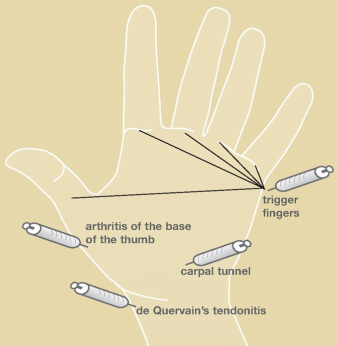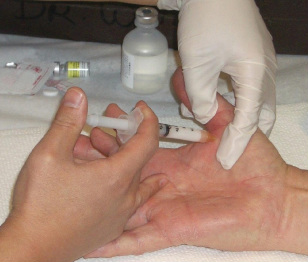MAKE AN APPOINTMENT TODAY!
Steroid InjectionsCorticosteroid or steroid injections are commonly used to treat a variety of inflammatory conditions of the upper extremity. Examples of these include steroid injections for trigger finger (stenosing tenosynovitis), de Quervain’s tendonitis, carpal tunnel syndrome, arthritis, tennis elbow (lateral epicondylitis), and rotator cuff tendonitis (see Figure 1).
What is a corticosteroid injection?Steroid injections typically contain a mixture of a synthetic cortisone and a local anesthetic such as lidocaine or bupivacaine. Cortisone is a steroid normally produced by the adrenal gland and is a powerful anti-inflammatory. There are several available synthetic preparations such as triamcinolone, betamethasone, and dexamethasone, and they are also commonly referred to by their trade names. They all have similar mechanisms although they vary in strength and duration of action (short versus long-acting). No single preparation has been found to be superior to others so the choice of medication is left up to the individual provider. These anti-inflammatory steroids are distinctly different from the anabolic steroids that have been abused by some athletes for body-building and performance enhancement. The local anesthetic dissolves the steroid and anesthetizes the area of the injection, diminishing discomfort during the procedure.
|
How does corticosteroid injection work?Steroid injections work by decreasing inflammation. Once the inflammation subsides, the associated pain usually improves as well.
How are steroid injections performed?The area to be injected is first cleansed with an antiseptic such as an iodine preparation,alcohol, or other skin disinfectant. The injection is then given with a small needle (see Figure 2). Typically, only a small amount of steroid and local anesthetic is injected. Afterwards, the area is covered with gauze or an adhesive bandage.
Steroid EffectsSteroid injections should take effect within a few days and the benefits can last for many weeks. The exact timing, however, varies from patient to patient. For some conditions, one injection can be sufficient to completely get rid of the inflammation and pain while for more severe cases, several injections may be required. Most patients respond well to injections although a small subset may not experience any relief of symptoms.
|
Frequency of Steroid Injections
There is no set rule as to how many injections a person can get. Many providers use three injections as a rule of thumb although, in some cases, more frequent injections may be helpful. Your response to the first injection is very important in determining whether to proceed with re-injection: If the first injection doesn’t work or wears off quickly it may not be worthwhile repeating. Many providers limit the number of injections because repeated cortisone may cause damage to tendons and/or cartilage.
Steroid Side Effects
The most common side effect is known as a cortisone flare. This is thought to happen when the steroid crystallizes after being injected. In patients who experience a flare, a brief episode of pain lasting one or two days follows the injection. This pain can be worse than the initial discomfort for which the injection was given. Cortisone flares resolve spontaneously over a few days and can be treated with ice and immobilization. Another common side effect, especially in patients with darker skin, involves skin discoloration at the injection site. The skin becomes locally lighter in color and sometimes thinner. Although this can improve, the whitening of the skin can sometimes be permanent. One of the more serious complications from steroid injections is an infection, especially if the injection was given into a joint. Fortunately infections are rare and can usually be prevented by carefully cleaning the skin before performing the injection. Very rarely, some patients may experience allergic reactions to the steroid or local anesthetic in the injection. Patients with diabetes will often notice a transient increase in their blood glucose in the days following a steroid injection.
When should you call your health care provider?
If you have received a steroid injection and the area is bright red, warm to the touch, or your temperature is greater than 101° orally, you should call your provider to check for an infection.
Reproduced with permission from the American Society for Surgery of the Hand www.handcare.org
Disclaimer and Privacy
IZADIHAND.COM © 2011-2022 Kayvon David Izadi MD - All Rights Reserved
Webmaster
IZADIHAND.COM © 2011-2022 Kayvon David Izadi MD - All Rights Reserved
Webmaster


